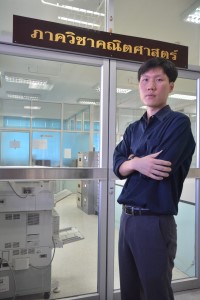ผศ.ดร.กลศ พัฒนะรพีเลิศ
Assistant Professor Dr.Klot Patanarapeelert
ห้องทำงาน 1555อาคารวิทย์ฯ 1 มหาวิทยาลัยศิลปากร วิทยาเขตพระราชวังสนามจันทร์
เบอร์โทรศัพท์: 034-245320-1 ต่อ
E-mail: klotpat@gmail.com
Assistant Professor Dr.Klot Patanarapeelert
ห้องทำงาน 1555อาคารวิทย์ฯ 1 มหาวิทยาลัยศิลปากร วิทยาเขตพระราชวังสนามจันทร์
เบอร์โทรศัพท์: 034-245320-1 ต่อ
E-mail: klotpat@gmail.com
ประวัติการศึกษา
- วท.บ (คณิตศาสตรประยุกต์) สถาบันเทคโนโลยีพระจอมเกล้าพระนครเหนือ (2541)
- วท.ม. (คณิตศาสตร์ประยุกต์) มหาวิทยาลัยมหิดล (2545)
- ปร.ด. (คณิตศาสตร์) มหาวิทยาลัยมหิดล (2549)
บทความวิชาการ
- ณิชาภัทร พัฒนะรพีเลิศ และ กลศ พัฒนะรพีเลิศ, แบบจำลองทางคณิตศาสตร์กับการควบคุมทางชีวภาพของแมลงศัตรูพืช Mathematical modeling with biological pest control, วารสารวิทยาศาสตร์ประยุกต์, (13)2: 100-106 (2014)
- กลศ พัฒนะรพีเลิศ และ ณิชาภัทร บุญก่อเกื้อ, แนวคิดทางคณิตศาสตร์ในระบาดวิทยาเชิงทฤษฎี Mathematical concept in the theoretical epidemiology, วารสารวิทยาศาสตร์ประยุกต์, (10)2: 62-67 (2011)
ผลงานวิจัย (Proceedings)
- U. Srip Sriphanomwan, N. Boonkorkuea, K. Patanarapeelert, A mathematical model of coral bleaching subject to the fluctuation of sea surface temperature, AMM 2012, April 26–27, 2012
- K. Patanarapeelert, Effect of human mobility on an epidemic threshold. Chiangmai University International Conference 2011, Vol. 1, No. 1 (2010) 62-71.
- I-Ming Tang and K. Patanarapeelert, Effect of time delay on the transmission of dengue fever, Proceedings of the 2nd IMT-GT 2006 Regional Conference on Mathematics, Statistics and Applications: Volumn II.
Research Articles
- N. Patanarapeelert, K. Patanarapeelert, Forecasting number of students in University department: Modeling approach, Open Journal of Applied Sciences, Vol. 3 (4), (2013), 293-297.
- K. Patanarapeelert, D.G. Lopez, I-M Tang, M.A. Dubios, Theoretical investigation of the impact on epidemic threshold of travel between communities of resident populations, J. Biol. Syst., 21, 1350010 (2013)
- S. Puangsun, K. Patanarapeelert, An SIR epidemic model with gravity in patchy environment: Analyses for two patches system, KMLTL Sci. Tech. J. Vol.12 No.2 Jul.-Dec. 2012.
- K. Patanarapeelert, T.D. Frank, I-M Tang. From a cellular automaton model of tumor-immune interactions to its macroscopic dynamical equation: A drift-diffusion data analysis approach. Math Comput Model 2011 Jan;53(1-2):122-30.
- T.D. Frank, K. Patanarapeelert and P.J. Beek, Portfolio theory of optimal isometric force production: Variability predictions and nonequilibrium fluctuation-dissipation theorem, Phys. Lett. A. 372 (2008), pp. 3562-3568.
- K. Patanarapeelert, T. D. Frank, P. J. Beek, R. Friedrich and I. Ming Tang, A data analysis method for identifying deterministic components of stable and unstable time-delayed systems with colored noise, Phys. Lett. A, 360(2006), pp. 190-198.
- K. Patanarapeelert, T. D. Frank, P. J. Beek, R. Friedrich and I. Ming Tang, Theoretical Analysis of Destabilization Resonances in Time-delayed Stochastic Second-order Dynamical Systems and Some Implications for Human Motor Control, Phys. Rev. E 73, 021901 (2006).
- K. Patanarapeelert, T. D. Frank, R. Friedrich and I. Ming Tang, On Reducible Nonlinear Time-delayed Stochastic Systems: Fluctuation-dissipation Relation, Transition to Bistability, and Secondary Transitions to Non-stationarity, J. Phys. A: Math Gen. 38(2005), pp. 10069-10083.
- T. D. Frank, K. Patanarapeelert and I. Ming Tang, Delay- and Noise-induced Transitions: a Case Study for a Hongler Model with Time Delay. Phys. Lett. A, 339(2005), pp. 246-251.
- H. Nishiura, K. Patanarapelert, M. Sriprom, W. Sarakorn, S. Sriyab and I. Ming Tang, Modeling Potential Responses to Serve Acute Respiratory Syndrome in Japan: the Role of Initial Attack Size, Precaution, and Quarantine, Journal of Epidemiology & Community Health, 58(2004), pp. 186-191.
- H. Nishiura, K. Patanarapelert, P. Khortwong, I. Ming Tang and A. Passakorn, Predicting the Future Trend of Drug-resistant Tuberculosis in Thailand: Assessing the Impact of Control Strategy, Southeast Asian J Trop Med Public Health, 35 (3)(2004), pp. 649-656.
- P. Pongsumpun, K. Patanarapelert, M Sriprom, S. Varamit and I.M. Tang, Infection Risk to Travelers Going to Dengue Fever Endemic Regions, Southeast Asian J Trop Med Public Health, 35(1)(2004), pp. 3168.


